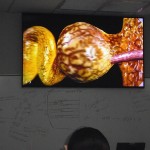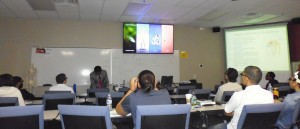3D in Education
After penning Nevada State College Flies High with 3D, I decided to pay a site visit to the venerable college. That’s because it’s always good to test one’s assumptions against hard reality. So, hoping to see 3D in action, hoping to determine if these undergraduate classrooms were indeed using stereo 3D in unparalleled ways, I ventured forth. The site visit was well worth my time.
Nevada State College, which is located just outside Las Vegas, began a high visibility 3D project this fall by purchasing and implementing a stereo 3D learning approach in all of their undergraduate science and nursing classes. This represents a significant step, because most stereo 3D projects at the college level take place in a single classroom of an interested professor—and not broadly across a curriculum.
Professor Vikash Patel
As I stealthily crept into the back of the classroom, the day’s lesson already underway, I took note of the physical lay of the land. The classroom was a typical college setting, with tabletops, whiteboards, a screen, projector, and significant digital lectern space. On the wall, above the whiteboard, a large 3D display monitor was mounted. The high-energy instructor, Professor Vikash Patel, was busy cajoling, informing, and questioning a room full of mixed-gender nursing students. All in all, the scene remained quite unremarkable, at least from my higher-ed perspective. What I witnessed next, however, was indeed quite remarkable and informative on many levels:
The Lesson. The lesson involved a review of the nephron, the basic structural and functional unit of the kidney. What was unique was his side-by-side lesson approach: 2D, then stereo 3D. First, he explained how kidneys filter blood using the tiny nephrons to create filtrate. Using both his lecture and PowerPoint visuals, he showed how filtrate ended up becoming the final product, called urine. But then Professor Patel switched to a captivating stereo display, and took the students on a virtual field trip inside the kidney. He navigated inside the glomerulus, which is a tuft of blood vessels in the initial portion of the nephron where filtration specifically occurs.
 A 2D nephron
A 2D nephron
 A 3D nephron view
A 3D nephron view
The Content. This stereo content was rich, remarkable, and simply unparalleled in quality. The textures, the colors, the closeness—all were simply striking. Part of the powerful effect of this lesson was created by the nature of simulation itself. As I wrote in a previous article:
I had seen the software before, of course, but I had never seen its impact on a class full of students. It was all I had hoped for.
The Students. Immediately after the lesson, Dr. Andy Kuniyuki (Dean of the NSC School of Liberal Arts and Sciences) sought some feedback from the students about the college’s new 3D investment. Specifically, he asked these students how the 2D component of the lesson compared with the stereo 3D part of the lesson. The responses of the students evidenced no hints of timidity:
The technology behind this—the ability to see within, to see inside the structures is unparalleled.
I basically agree… we were able to go inside a smoker’s black lung a few weeks ago. This doesn’t compare with the PowerPoint [graphics] at all.
It’s very good to have the ability to rotate an object, to get that 3D anatomical feel; if you have a ‘flat’ [2D] slide, you wonder what it really looks like.
Someone like me, who learns from touch, I identify better with the concept. [It’s like] I can almost touch it. This last comment, uttered by a female student, is noteworthy. Dean Kuniyuki hears the same refrain from other students on campus: “The visualization through the 3D system allows you to feel as if you could touch something, enhancing their learning- it’s so rich”, echoes Dean Kuniyuki.
 Stereo 3D and 2D side by side at Nevada State College
Stereo 3D and 2D side by side at Nevada State College
The Brewing Impatience. As stated previously, Nevada State College is using Sensavis’s flagship educational product, “The 3D Classroom.” This software offers an array of effective simulations. “But we want more”, insists Dean Kuniyuki. “We know that Sensavis is working on five more simulations. Still, we are rather impatient.” Dean Kuniyuki wants to aggressively push the envelope of content. “We want to be able to show a normal nephron, and then take a look at an unhealthy kidney (with five different diseases) that affect the functioning of the kidney in different ways-normal versus diseased state, if you will.” With his bias toward action, Dean Kuniyuki recently brought an experienced animator from Montreal on staff. So much for trickle-down content.
 Andy Kuniyuki, Ph.D.
Andy Kuniyuki, Ph.D.
Dean, School of Liberal Arts and Sciences
*****
I am glad I made this site visit. I had the chance to witness a deep and unparalleled learning experience. And since I know the classroom well, I know what that means. Incidentally, an LA-based leader in the 3D entertainment industry joined me on this site visit and offered the same reaction. I hope the manufacturing industry never gives up on the unparalleled advantages of learning with 3D. -Len Scrogan

